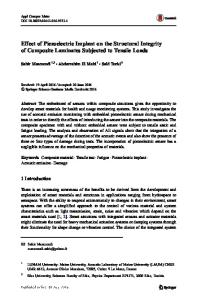Nonlinear instability of a thin laminated composite circular plate subjected to a tensile periodic load
- PDF / 1,202,386 Bytes
- 26 Pages / 595.276 x 790.866 pts Page_size
- 9 Downloads / 305 Views
O R I G I NA L PA P E R
Khaled M. Elmorabie
· Kadry Zakaria · Magdy A. Sirwah
Nonlinear instability of a thin laminated composite circular plate subjected to a tensile periodic load
Received: 26 December 2018 / Revised: 15 May 2020 © Springer-Verlag GmbH Austria, part of Springer Nature 2020
Abstract In this work, we have investigated the nonlinear instability behavior of a thin laminated composite circular plate subjected to a tensile periodic load. A nonlinear system with quadratic and cubic nonlinear terms, referred to the effect of large deflection, is obtained. The method of multiple time scales is used to obtain periodic solutions for the second- and third-order systems, which directly leads to the solvability conditions of the two orders including the nonlinearity terms. Different cases of resonance with the instability criteria are taken into account. For the numerical application, the effect of the tensile periodic load was studied on a plate of graphite fabric-carbon material.
1 Introduction The ability of fiber-reinforced composite materials for the strength and stiffness properties with lightweight made them superior compared with metals and made it increasingly used in automotive and structural engineering as well as in many other applications in aerospace technologies and industrial structures. One of the most interesting fields of study of laminated composite plates and their dynamic stability under periodic in-plane load are the micro-electromechanical systems (MEMS), which are usually used as coolant pressure sensors. Many theories of plates subject to a static or dynamic load are developed, and the associated problems were classified in many ways; one way of classification is based on the thickness of the plate (thin-thick plate theory). If the thickness ratio h/R of the plate is less than 1/20, the plate is said to be thin (Bairagi 1986), otherwise the plate is thick. In thin-plate theory, the components of the stress σz , τr z , and τθ z , in z-direction across the thickness, can be neglected as their magnitudes compared to the other stress components are small and this cannot be assumed in the thick-plate theory. The thin-plate theory is classified according to the transverse deflection w relative to the thickness of the plate h into two cases. In plates with small deflection, in this case w, is small compared to the plate thickness. So in the small-deflection theory, the bending impact is dominant whereas the membrane effect is totally disregarded which is the so-called Kirchhoff-plate theory. Plates with large deflection, both membrane and forces, take part in resisting the action of the external loads. The larger the deflection is, the larger are the membrane and curvature actions. The most commonly used theory for plates under large deflections is the von Kármán plate theory which will be used in this work. When a composite K. M. Elmorabie (B) · K. Zakaria · M. A. Sirwah Faculty of Science, Tanta University, Tanta, Egypt E-mail: [email protected] K. Zakaria E-mail: kad
Data Loading...











